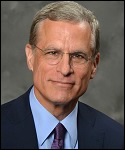By Pam Martens and Russ Martens: October 8, 2021 ~
Dallas Fed President Robert Kaplan is due to step down today after playing a central role in creating the worst trading scandal in the Federal Reserve’s 108-year history.
Not only was Kaplan trading in and out of “over $1 million” positions in individual stocks but he was also engaging in “over $1 million” transactions in S&P 500 futures, an instrument used by hedge funds and day traders to make leveraged bets on the direction of the market. As Wall Street On Parade previously explained, a dozen legal safeguards had to fail to allow this to happen.
The Dallas Fed has refused to say if Kaplan was shorting the market. It has also refused to provide the dates of Kaplan’s trades, despite the fact that the Dallas Fed’s own financial disclosure form requires Kaplan to provide that information. Other Fed Bank Presidents readily comply with providing the dates of their purchases and sells, as do all of the Federal Reserve Board of Governors.
On Wednesday, we sent an overnight letter to Thomas J. Falk, the Deputy Chair of the Dallas Fed Board of Directors, who is one of the three Dallas Fed Board Members appointed by the Federal Reserve Board of Governors to represent the public. Falk is the retired former Chairman and CEO of Kimberly-Clark, thus we felt he could readily appreciate his fiduciary duty to comply with existing rules and regulations and fulfill the public’s right to know. We asked that Falk instruct staff at the Dallas Fed to comply with our previous requests for the dates of Kaplan’s transactions.
Senator Elizabeth Warren has called on the Securities and Exchange Commission to open an investigation into insider trading by Fed officials. Boston Fed President Eric Rosengren has also stepped down from his post after his trading in and out of stocks and REITs came under fire. Media questions are also being raised about one large trade done by the Federal Reserve Board’s Vice Chair, Richard Clarida, who sold between $1 million and $5 million in a bond fund and moved it into stock funds in February of 2020, on the eve of Fed Chairman Powell issuing a statement suggesting policy action from the Fed in response to the pandemic.
But the trading by Rosengren and Clarida pales in comparison to a Fed Bank President repeatedly trading in “over $1 million” transactions in S&P 500 futures, as was done by Kaplan — not just in 2020 but since Kaplan joined the Dallas Fed in September of 2015. Traders on Wall Street are astonished that Kaplan hasn’t been perp walked in all this time. (See Kaplan’s 2015 through 2020 financial disclosure forms here.)
The E-mini S&P 500 futures contract is the most popular and liquid S&P 500 futures contract. It can be leveraged by as much as 95 percent. The stock exchanges are only open in the U.S. from 9:30 a.m. to 4 p.m. (EDT) weekdays, but the E-mini trades continuously from 6 p.m. Sunday night through 5 p.m. on Friday evening (EDT), allowing someone who might wish to trade on inside information an open runway to do so.
Yesterday, we stumbled across a fascinating article of what Dallas Fed President Robert Kaplan was doing with some of his spare time at the Dallas Fed when he wasn’t making market-moving statements to the press or making “over $1 million” stock and S&P futures trades.
In December 2016, D (short for “Dallas”) CEO Magazine published an article by Glenn Hunter titled: Why You Need to Know Robert Steven Kaplan. It included this thought-provoking insight:
“Because as president and CEO of the Federal Reserve Bank of Dallas, Robert Steven ‘Rob’ Kaplan oversees 1,200 Fed employees and, as a member of the Federal Open Market Committee, uses market intelligence provided by local businesspeople to formulate U.S. monetary policy. [Kaplan was a rotating voting member of the FOMC but allowed to sit in on its deliberations at every meeting.]
“Kaplan gathers the latter in part with a monthly round of calls to leaders of about 25 small, midsized, and large companies in a variety of industries throughout the Fed’s 11th district, which includes Texas and parts of Louisiana and New Mexico. Each call lasts roughly half an hour, Kaplan says, and covers a variety of topics. Is the company growing or not growing? he’ll ask. What are the executive’s thoughts on regulation? Disruptive competitors? Access to capital? What’s the most notable thing he or she is seeing in the marketplace?”
Clearly, these businesses thought they were providing confidential market intelligence to an extension of the U.S. central bank – not to provide Kaplan with market intelligence to trade his personal account.
Texas is home to some of the largest corporations in America. A small sampling of recognizable names that are headquartered in Texas includes: American Airlines, AT&T, Dell, Exxon Mobil, Halliburton, Keller Williams Realty, Kimberly-Clark, Neiman Marcus Group, Pizza Hut, Schlumberger, Southwest Airlines, Texas Instruments, Tenet Healthcare, Waste Management, and Whole Foods Market.
According to Kaplan’s 2015 and 2016 financial disclosure forms, Tenet Healthcare is one of the stocks he was trading in and out of.


